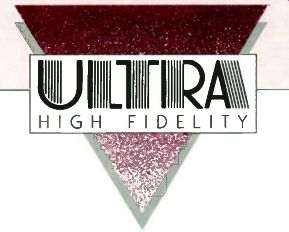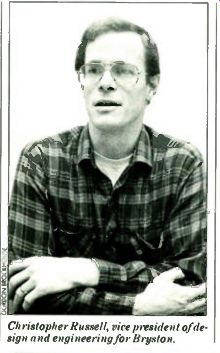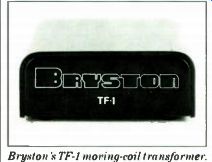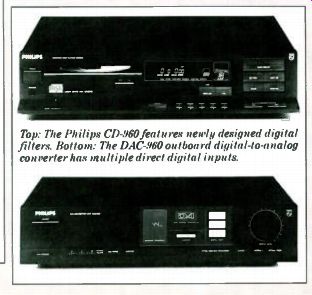
When HIGH FIDELITY began publication back in 1951, it catered to a relatively small group of devotees. Equipment capable of full-bandwidth, low distortion music reproduction still was scarce, and enthusiasts often built some of their own gear (especially loudspeakers). The diversity of products and sophistication of design we now take for granted were still far in the future.
Today's audio-video market is astonishingly broad, ranging from $60 portable tape players to $40,000 speaker systems, from $300 VCRs to $5,000 projection television sets. But for those who really care, the goal is still the same. ULTRA HIGH-F IDELITY will focus its coverage on equipment, manufacturers, and recordings that remain true to the impulse that started it all by striving for the finest possible reproduction of sound and image, regardless of cost. - Michael Riggs/Editor
On this page:
- Sounding Off
- Philips CD Players
- Classical Music
Sounding Off
BY GORDON BROCKHOUSE
AN INTERVIEW WITH CHRIS RUSSELL OF BRYSTON, LTD.
With this issue, ULTRA HIGH FIDELITY presents the first of a series of interviews with high-end manufacturers. The first company represented-Bryston, Ltd., of Toronto, Canada-is unique for its success in both the professional and audiophile markets. In both fields, Bryston makes preamplifiers and power amplifiers as well as accessories like moving-coil transformers, speaker switchboxes, and electronic crossovers.
Design and engineering are the responsibilities of vice-president Christopher Russell, who oversees a staff of four. HIGH FIDELITY contributor Gordon Brockhouse spoke with Russell at Bryston's head office in Toronto. The thirty-nine-year-old designer discussed his company's products and the philosophy behind them as well as his approach to audio in general. Russell's interest in audio started in his teens, when he listened to the Stones and the Beatles and attended live concerts of every kind of music.
CR: I realized that the sound systems of the day [1960s] were approaching the kind of feeling you get at a live performance, but there was still an emotional response you couldn't re capture. It became a challenge to look into things that would elicit the same response music generates in a live setting.
GB: When did Bryston start building audio equipment?
CR: In 1972. I had been with the company for three or four years, as a student-a boss's-son type of thing. It occurred to me that we ought to have a line of products that featured Bryston's name prominently.
My own interests were in audio and high fidelity amplification. For approximately a year, we did re search, testing, and prototyping. We came up with something we thought was an improvement on available products and gave it to a Toronto sound studio to test. They found that our amplifier was more musically accurate than what they'd been using. It was actually giving them more in formation and hiding less of the detail they needed to hear for mixing and mastering.

---- Christopher Russell, vice president of design and engineering
for Bryston.
That, of course, was very encouraging, because it told us that our ideas had a lot of merit. Some of them were sizable departures from the philosophies of amplification at the time.
So, we accepted their order for some monitoring amplifiers and built them in a very short production run; then we approached other studios. It grew pretty quickly from there. It seemed to us that perhaps we had an application in high fidelity home amplifiers as well. In 1974, we started with one store in Toronto.
GB: How did the design of your products differ from those then available?
CR: At the time, no one had really thought about slew-rate limiting. We felt that available amplifiers couldn't deliver the power at high frequencies they could at midband. Back in the early '70s, transient intermodulation distortion hadn't been considered much. Square-wave performance of most amplifiers was severely limited. Low-power rise time was much different from high-power rise time. We thought that might be important when amplifiers were used at high sound levels.
Another departure was complementary circuit design. Amplifiers did not use the same circuitry on both ends [positive and negative halves] of the waveform. That added second harmonic distortion that was causing high-order problems, sort of gritty and harsh-sounding mechanisms. So we adopted the concept of complementarity.
We also felt that much of the blurring in some solid-state amplifiers resulted from power-supply interaction between channels. We felt that an amplifier should have a separate power supply for each channel, an approach that has since become extremely popular. We found it improved imaging drastically. In addition, it was unusual [then] to have regulation within the power supply. We felt that at least the low level voltage supplier to the gain stages ought to be strongly regulated so that they were essentially imperturbable.
We also wanted to make sure the amplifier had open-loop linearity, as opposed to a lot of feedback that would correct inherent distortion.
This also has become popular. We felt that we'd wind up with a more musically accurate product, one that would sound easier, less strained.
GB: What refinements ha ve you added since then?
CR: Our newest amplifiers have four way complementarity within the out put section. The same kind of transistors operate on both halves of the waveform, so that the "bottom" half of the amplifier hands the signal over to the "top" half with exactly the same amplification circuitry, not just a complementary inverse of it. The complementarity is so extreme that it linearizes the output transfer function, almost eliminating low-level crossover artifacts. There appears to be a highly audible improvement.
Bryston doesn't make new-product announcements until after product has been shipped. Invariably when we make improvements, we receive an unsolicited reaction from our dealers. It's quite startling some times. When we began using the out put circuit I've been describing, some dealers said the amplifiers they had on their shelves were obviously defective, because the new ones sound ed so much better. But we're not head-in-the-clouds tweekophiles. Any improvement we make has to be backed up with audible and electrical improvements that we can document.

Bryston's TF-1 moving-coil
transformer.
GB: Among both press and enthusiasts, there seem to be two extremely different approaches to amplification. One is that amplifiers sound no different if traditional measurements such as bandwidth, signal-to noise ratio, and harmonic and intermodulation distortion are similar. At the other extreme is a subjective approach with a very exotic vocabulary used to describe perceived differences. Where do you stand here?
CR: It's a funny thing-we can easily prove both philosophies correct. Sup pose you subject someone to a blind test of two products, where he doesn't know what he's listening to.
If you correlate data over enough trials, his choices boil down to pure guesswork.
At the same time, you can't argue with the results we've had shipping improved products and waiting for unsolicited responses. The guy gets a new amplifier with a circuit improvement. He hasn't any reason to suspect a circuit improvement but immediately notices something and asks us why the amplifier sounds so much better in one specific area.
True, that's anecdotal evidence, which is almost invariably rejected by any scientific study. But you can't argue with the same thing happening again and again. Every time we do something that we can document as an improvement, people prove they can hear it.
I've whimsically come to refer to this as my "Zen" perception of the art of audio listening. It's a dual-reality kind of thing. You can prove scientifically that no one can hear the difference between an amplifier with one percent distortion and one with one thousandth of one percent. But at the same time, when you await people's unsolicited responses to a documentably better product, they almost al ways choose the thing that can be proven to be better.
GB: What other factors do you believe make an amplifier or preamplifier sound better?
CR: It comes down to making the amplification very linear, with very low distortion in the uncorrected condition (in the absence of feedback or feed-forward correction). Because music is almost all transients, linear amplification of transient signals really is our most basic criterion.
That takes us into several areas.
Amplification is quite subject to non linear distortions based on changes in the power supply. If the supply is changed in response to the musical waveform, it's going to cause some kind of intermodulation or cross-modulation effect. So one of the things we do is make sure that the amplification is fed from a stiff, imperturbable power supply.
GB: There's a trend toward loose power supplies to give the amp very high instantaneous-current capabilities. Do you feel that's an error?
CR: As an alternative to clipping, I don't disagree with it. But I do disagree if the power supply is jumping all over the place. A loose power sup ply doesn't really give high current output; it gives high idling voltage capability. The amplifier tends to idle at a relatively high power-supply voltage. When the amplifier is delivering substantial current-perhaps when a low-frequency waveform is being fed to a woofer--the impedance can fall to low levels to the point where the power supply collapses. We consider that dangerous, because the amplification is being sourced from a modulated power supply. This makes the amplifier sound mushier. The imaging tends to wander, and you wind up with a soundstage that isn't as obviously three-dimensional.
In terms of sizing up its acoustical environment, the ear is remarkably proficient at listening to low-level artifacts. Suppose you were taken blindfolded into a large space such as a symphony hall or gymnasium, and had no previous knowledge of where you were being taken. Within seconds, you'd be able to describe the space in close detail simply by listening to the echoes that come back from your breathing, from your footsteps, from your voice.
Think of that in terms of listening to a musical reproduction. Most of what you're listening to, in terms of placing the music in the acoustical environment where it was recorded, involves interpreting low-level echoes and reverberations dying away into the background. That happens at remarkably small acoustical levels.
When you start changing the linearity of transient application into an amplifier, low-level information gets blurred, distorted, and, in many cases, lost. So we're wary of throwing a flaccid power supply into an amplifier to give the illusion of high transient-output capability.
GB: What other factors do you find influencing sound quality?
CR: We consider the quality of the actual components-active or passive- very important. Individual component distortions, though very low, have an audible effect.
A few years ago, we were using carbon-film resistors throughout our amplifiers. In one particular location in the feedback loop, the nonlinearities of a resistor have a direct effect on total distortion. Over a low-frequency waveform, a carbon film resistor heats and cools twice per cycle as it goes through positive and negative peaks and a zero crossing. This inserts an extremely low-level, but still measurable, second-harmonic distortion component onto the signal.
We were able to eliminate that by substituting a metal-film resistor with a vanishingly low temperature coefficient. Although it's a very simple distortion mechanism, it appears to have been something that people were aware of in its absence. When we shipped the new amplifiers, we received a lot of phone calls.
We now use metal-film resistors throughout all of the amplifiers--even though, in many cases, the distortion mechanisms generated by carbon-film resistors might be hidden in the background. We also use polystyrene capacitors and controls with 1/4-dB tracking. You might as well use the best components. That way, you have no excuses, and you don't end up second-guessing yourself.
Very happily, we've also had tremendous success with component reliability. Our original amplifiers used off-the-shelf computer-grade filter capacitors. They had a relatively good reliability record, but we saw them as an inherent limitation in the long-term reliability of the amplifier.
So we conducted a design study, which we can now take to component manufacturers. For instance, the [capacitor's] tab root has to be welded to the internal foil. In times past, it was riveted, a potential source of unreliability. The electrolyte must be extremely pure, because we found that low-level contaminants could cause long-term reliability problems. Heat sinking the foil within the [capacitor] improves reliability by reducing heat buildup. We now have been able to de scribe this component to the degree that we essentially have almost perfect reliability.
We're doing that with all components. We look for causes of break down problems in the field and correlate them with construction methods, even things like the compound we apply to internal screws, nuts, and bolts. Anything that goes together to build the amplifier is sealed so that the amplifiers will be vibration-resistant when they're used for live sound reinforcement, which a lot of our stuff is.
These are things we consider to be our forte, our stock-in-trade: extreme sound quality with extreme reliability. That's how we can serve both the pro- and home-audio markets.
GB: Do you build the same product for both markets, or are there different design criteria?
CR: As a matter of fact, the basic amplification circuitry is exactly the same for the two markets, but with adaptations for the professional marketplace such as balanced inputs, level controls, and different kinds of input jacks.
There are very few professional sound-equipment manufacturers who have any kind of following in the audiophile marketplace. You could probably count them on the thumbs of one hand. We consider it a lovely thing that we are able to have that kind of following.
GB: What's your view of the current state of the art? What are the most promising areas of endeavor?
CR: The goal is to preserve the emotion of the original performance. It's startling how much can be lost in the translation to a recorded medium.
Capturing the things that your ear responds to in a live environment is one of the most potentially fruitful areas of research.
A promising area of research involves adapting the listening environment. This is largely unexplored in most people's systems. The listening environment can be arranged so that it is, to some extent, ignorable. If it is made innocuous enough, it can be processed out by the ear. That's one of the wonderful things about the hearing mechanism: It is able to perceive through things and listen through to the original recording.
The original recording is at least as important, in terms of disturbing critical low-level signals and in terms of the description of the original environment. I'm very excited about the possibilities that are approaching very quickly.
--------- Gordon Brockhouse was an editor of Canadian audio and computer industry trade publications. -------
PRODUCT NEWS
Philips's Best
If you've read "Currents" elsewhere in this issue, you already know that Philips has introduced a new line of audio and video products under its own brand name (it already sells some of its CD players under the Magnavox label). Leading the attack on the audio front is the company's best consumer-model CD player, the CD-960, which can be used in tandem with the DAG960 outboard digital-to analog (D/A) converter to provide the foundation for a more complete digital audio system.
First, the player. At its heart is a pair of Philips's latest 16-bit D/A converters with new four-times-over sampling digital filters. The new filters are said to improve attenuation of out-of-band frequencies, as well as to offer complete muting of uncorrectable errors caused by severe soiling or damage to a disc. Performance specifications are given as follows: 101-dB signal-to-noise ratio, 96-dB dynamic range, and 100-dB stereo separation (at 1 kHz). The CD-960 weighs nearly 21 pounds; its die-cast chassis alone ac counts for 4 1/2 pounds. The laser assembly-the same as that used in Philips's professional CD players-is said to be highly resistant to the bumps and vibrations that cause mistracking. Separate motors are used for disc loading and clamping, and the disc drawer closes when you press the play but ton or the door itself.
In addition to a conventional analog output, the CD-960 delivers the unconverted digital signals through one of two outputs: optical (via a fiber-optic cable) or electrical (over a coax cable with regular pin jacks). Either digital output can be fed to the DAC-960 for conversion to analog, although the optical path offers complete freedom from signal loss and electrical interference.
Operating features are highlight ed by Favorite Track Selection (FTS), previously seen in the well-received Magnavox CDB-650 player (test re port, April 1987). FTS enables you to program a sequence of track numbers, index points, and time segments for a particular disc and to store that information along with the disc's identification code. Thereafter, when a disc is loaded, its FTS program is immediately available. Memory capacity varies depending on the type of programming information. For example, if you program an average of five tracks per disc, the FTS memory will hold as many as 155 discs. A wire less remote control duplicates most of the front-panel operating controls.
----- Philips is the co-developer of the Compact Disc format. ---
If the CD-960 is so good, why would you want to bypass it and in stead use the converter circuitry in the DAC-960 outboard converter? The DAG960 does have internal optical coupling to carry the output of the digital filters to the D/A converters, although that difference is unlikely to improve the sound. But the DAG 960 is more than just a companion for the CD player; it's a multi-input converter for use with future digital components such as DAT decks, digital equalizers, and other digital signal processors. In that light, it offers a choice of three digital inputs (one specifically for the CD-960's optical out put) plus a digital monitor loop for a DAT deck or a digital signal processor. The correct sampling rate for the incoming digital signal is selected automatically: 48 kHz for DAT, 44.1 kHz for CD, and 32 kHz for DBS (Direct Broadcast from Satellite, not yet available in the U.S.). There is also a choice of three outputs for the analog signal: fixed, variable, or balanced (using XLR connectors typical of professional equipment). The variable output, controlled by a front-panel knob, can deliver a 4-volt signal-a level high enough to directly drive a power amplifier, making the DAC 960 a highly specialized preamplifier.
A switch on the front panel reverses the polarity of the analog output signal so you can switch back and forth and listen for any difference (there's almost no way of finding out the absolute phase of the source signal, but we have yet to detect with music an audible consequence of reversed phase). In addition to the variable line output, a head phone jack with its own volume control is included.
Both the CD-960 and the DAC-960 have a suggested retail price of $949. For further information, contact NAP Consumer Electronics Corp., 1-40 & Straw Plains Pike, Knoxville, Tenn. 37914.

Top: The Philips CD-960 features newly designed digital filters. Bottom:
The DAC-960 outboard digital-to-analog converter has multiple direct
digital inputs.
CLASSICAL
The best sound, the best performances:
Compact Disc Classics
BY THEODORE W. LIBBEY, JR.
BACH: Orchestral Suites (4). English Baroque Soloists, Gardiner.
RCA Erato ECD 88048/49 (2). Superb renditions of these lively, beautifully written suites. The interpretations are gutty and expressive, and the playing is wonderfully accomplished. First-rate sound.
BERG: Violin Concerto.
BARTOK: Violin Concerto No. 1. Chung; Chicago Symphony Orchestra, Solti. London 411 804-2.
Excellent accounts of both works, with expressive but not overwrought playing from Chung and powerful support from Solti and the Chicago.
COPLAND: "Billy the Kid"; "Rodeo." St. Louis Symphony Orchestra, Slatkin. Angel EMI CDC 4 7382.
Lusciously recorded accounts of Cop land favorites, vividly interpreted and smartly played. There have been many recordings of the two ballets, but none more effective than these.
DVORAK: Symphony No. 8; Scherzo capriccioso. Cleveland Symphony Orchestra, Dohnanyi. London 414 422-2.
Rousing performances of these ebullient scores, notable for the virtuoso playing. Dohnanyi leads with authority, and the sonics are magnificent.
HAYDN: Symphonies Nos. 94, 96, 100t, 104t. Academy of Ancient Mu sic, Hogwood. L’Oiseau-Lyre 414 330 2, 411 833-2t.
Fine Haydn for the connoisseur of the Classical style. The accounts are lean and spirited, the textures often bitingly crisp. Good balance and admirable sound.
HOLST: "The Planets." Montreal Symphony Orchestra, Dutoit. London 417553-2.
The best-ever performance and re cording of the suite. In this characterful reading, Dutoit goes to the core of the music and elicits a stirring performance from the Montrealers. It is all captured in state-of-the-art sound.
MAHLER: Symphony No. 8. Various artists; London Philharmonic Orchestra and Chorus, Tennstedt.
Angel EMI CDC 47625 (2). A towering yet surprisingly intimate account of this sprawling work. Tennstedt achieves a minor miracle with the complex textures, and he shapes the climaxes with unerring skill.
Breathtaking sonics and splendid playing from the London Philharmonic combine to make this the most successful recording of the Eighth to date.
MONTEVERDI: "Vespro della Beata Vergine." Kirkby, Rogers; Taverner Consort and Chorus, Parrott. Angel EMI CDC 47077 (2). One of the gems in the catalog. An appealingly energetic realization of the score, superbly played and sung. The sound is exceptional.
MOZART: Clarinet Concerto; Oboe Concerto, K. 314t. Pay, Piguett; Academy of Ancient Music, Hogwood. L'Oiseau-Lyre 414 339-2.
The preferred recordings of both works. The Clarinet Concerto is played on a basset clarinet, as Mozart wrote it; the effect is meltingly pure.
Both soloists are excellent, and Hog wood delivers handsome accompaniments.
MOZART: Symphonies: No. 36, K. 425; No. 38, K. 504. Prague Chamber Orchestra, Mackerras. Telarc CD 80148.
Vigorous and muscular accounts of these symphonies, interpreted with a sure sense for the style but played on modern instruments and given full bodied sound by Telarc.
PROKOFIEV: Symphony No. 5; Waltz Suite, Op. 110, Nos. 1, 3, 4. Scottish National Orchestra, Jarvi. Chandos CD 8450.
A strongly etched interpretation that projects the darker side of the sym phony. The Scots play very well and are idiomatic to boot. The recording has enormous impact and dynamic range.
RACHMANINOFF: Symphonies (3); "The Isle of the Dead"; "The Rock." Berlin Philharmonic Orchestra, Maazel. Deutsche Grammophon 419 314-2 (3). Sharply chiseled, powerfully played, and insightfully conducted performances that-in the case of the Third, at least--recall the composer's own.
RESPIGHI: "Pines of Rome"; "Fountains of Rome"; "Feste romane." Philadelphia Orchestra, Muti. Angel EMI CDC 47316.
Muti is just right for this music, and he has the Philadelphians playing at the peak of their form. The sound is big, bold, and reverberant, accurately conveying the way the orchestra sounds in its new recording venue, Memorial Hall in Fairmount Park.
SCHUMANN: "Dichterliebe"; "Liederkreis." Bar, Parsons. Angel EMI CDC 47397.
Striking interpretations by the young East German baritone, harking back to Fischer-Dieskau. Bar's distinctive timbre and intensity are well captured. Excellent recording.
SIBELIUS: "Kullervo" Symphony; "The Origin of Fire"; "Our Native Land." Saarinen, Hynninen; Helsinki Philharmonic Orchestra, Helsinki University Male Choir, Academic Choral Society, Estonian State Academic Male Choir, Berg lund. Angel EMI CDC 47496 (2). Winner of a HIGH FIDELITY/International Record Critics Award in 1987.
Sibelius's granitic, powerful Kullervo Symphony is brilliantly realized, with Berglund presenting the results of many years' thought. The wealth of inner detail and the coherence of the account are both admirable, as is the playing of the Helsinki Philharmonic. Two rarely heard choral works fill out the set. Magnificent recorded sound.
Also see:
Bits & Pieces -- The real reason to want an 18-bit CD player.